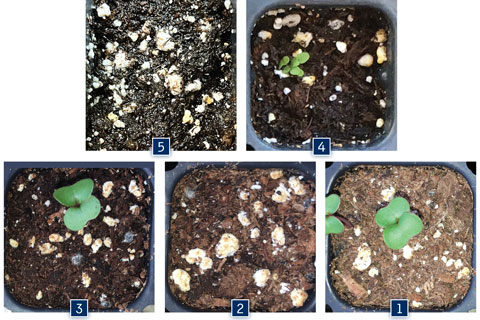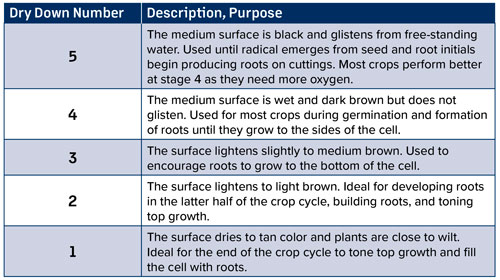1/1/2025
Taking Control Early
Troy Buechel

Building roots on young plants can be challenging. With poor weather conditions in winter and early spring, variable sun appearances, inconsistent rooting or germination, unknown plant genetics, etc., it’s difficult to build great roots. Although these issues are outside of a grower’s control, this article will cover some variables that can be controlled to help build great roots on young plants.
Growing medium selection
A common question is: What is the best growing medium for young plants? The answer depends on your needs and growing environment. Start by looking at where in the growing medium profile the seed or cutting will be placed. Seeds are often small and placed on the growing medium surface. They need maximum water placement around the seed, so the growing medium must retain plenty of surface water, making fine growing media the best option. Most seed germination media are composed of fine peat and fine perlite—the higher the ratio of perlite, the better drainage and higher air porosity the medium will have.
Cuttings, on the other hand, are inserted into the growing medium. The stem area from which the roots emerge is in the lower levels of the growing medium, so there’s less need for the growing medium to be wet from the surface to the bottom of the cell. Cuttings also have more surface area from which roots could emerge compared to seeds, so continuous water contact up and down the cutting isn’t as critical. Germination media may hold too much water for cuttings and have too little oxygen for ideal root growth. Therefore, some growers prefer a standard peat-perlite growing medium with coarser peat and perlite.
Growing medium handling
If your growing medium comes in a compressed bale, minimize the time it’s mixed, as the process will crush perlite and damage peat fibers, creating fine particles. Fine particles pack tighter, so the medium has low air porosity, negatively impacting root and plant growth. If possible, avoid compaction from roller dibblers, high water pressure, nesting filled trays on top of each other, or moving filled flats on carts (vibration causes more settling, especially if the medium is wet). Compacting the growing medium collapses large, air-filled pores, creating smaller water-filled pores with a lower percentage of oxygen-filled pores.
Watering
Plant roots aren’t aquatic structures. They indeed need to acquire water from the growing medium, but they also need the oxygen found in air-filled pores within the growing medium. When seeds are sowed and cuttings are stuck, high moisture levels are needed in the growing medium to encourage germination and root initiation. After seed germination or root initiation in cuttings has taken place, plant roots need higher levels of oxygen for proper root growth, so the goal is to wean young plants from high water levels in the growing medium to reduced water levels throughout the crop production cycle. But how can the watering requirements be determined?
A simple determination for watering young plants in a peat-perlite medium was developed by Paul Fisher at the University of Florida using a 5-to-1 numbered watering system, with 5 being a saturated growing medium to 1—the point at which a plant will wilt (Figure 1). These visuals help growers determine the proper dry-down point for each young plant crop and can be adjusted as young plants mature. Another tip is picking up plug or liner trays from the opposite ends and looking for downward bowing in the middle of the tray. The more moisture in the growing medium, the more the tray sags in the middle. These visual signs are tools used to train new growers on how to properly water young plants.

Figure 1. A 5-through-1 numbered watering system was developed to help identify proper dry-down points for young plant production. These are based on the visual color of the surface of a peat-perlite growing medium.
Overwatering issues
Overwatering young plants doesn’t occur by applying too much water at one time, but by watering too frequently, thereby the growing medium doesn’t dry out sufficiently for the stage of plant development. This means that most of the pore space within the growing medium is filled with water, leaving few pores with the needed oxygen for proper root growth. Lack of oxygen causes plant stress, making roots more susceptible to attack by pathogens, especially those that prefer wet growing medium, such as Pythium, Phytophthora and Thielaviopsis.
Overwatering provides the ideal environment for algae and mold growth within the growing medium, attracting shore flies and fungus gnats. The latter could feed on and damage plant roots if their populations become excessive.
Overwatering also changes root morphology. With a consistently saturated growing medium, “water roots” develop towards the growing medium surface and appear thin, slightly translucent, poorly branched, with few root hairs. Water roots cannot handle minor stress, including dry down of the growing medium. Furthermore, with the lack of root hairs—which take up much of the water and nutrients needed—plants tend to show premature onset of wilting and nutrient deficiencies.
Biologicals
When looking at a plant’s entire life cycle, it’s most susceptible to root diseases and environmental stress during the young plant stage. Therefore, select a growing medium that includes a biological to help reduce root disease incidence or apply a biological additive as a drench. Many of these “biofungicides” grow on the root system of the plant where they feed from the carbon-rich root exudates. Many produce high populations, forming a physical barrier around the roots, produce antibiotics, or in some cases, attack plant pathogens—all of which protect roots from root disease pathogens. Remember that the biofungicide must colonize plant roots before protection begins. Also, if conditions are favorable for root diseases, chemical fungicide drenches may be necessary to help biofungicides suppress root diseases.
 Table 1. Description of the root development during the 5-through-1 numbered watering system.
Table 1. Description of the root development during the 5-through-1 numbered watering system.
Endomycorrhizae also benefits young plants. Although it takes two to four weeks for plant roots to be colonized, young plants use mycorrhizae to help acquire nutrients and water that may otherwise be hard for the roots to obtain towards the end of the plug/liner stage. If a nutritional or pH problem occurs, mycorrhizae can delay nutrient deficiency symptoms, so root growth is optimized. Mycorrhizae will continue to colonize plant roots even after transplanting young plants into larger containers. GT
A specialist in floriculture and plant nutrition, Troy Buechel holds a Bachelor’s and Master’s degree in Horticulture. With Premier Tech Grower Services since 1995, he supports customers with crop, fertilizer and water-quality concerns. Troy has delivered numerous seminars, authored articles and created YouTube content to address horticultural challenges and solutions.